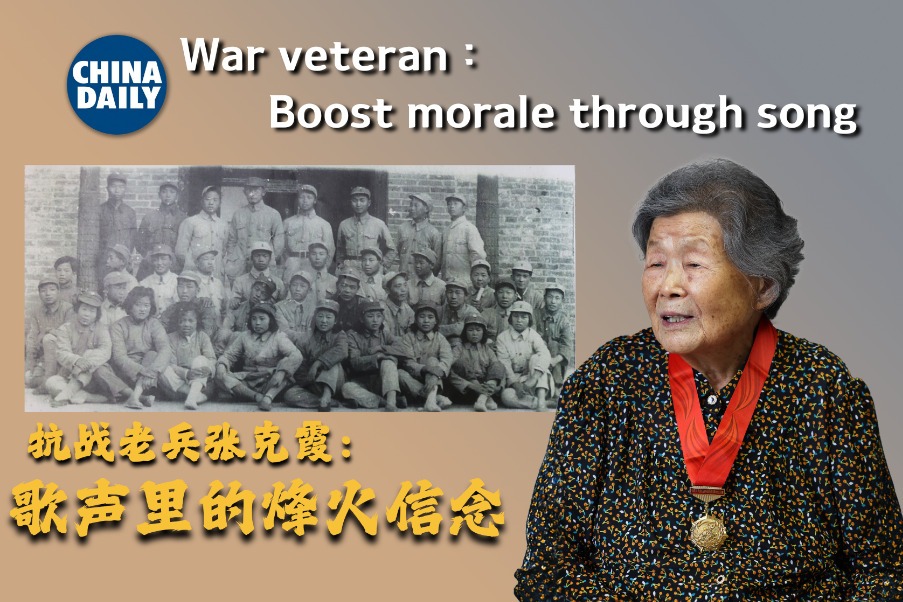Traditional art form rhymes with the times
With clappers in hand, verses are spoken to the sound of another era, Chen Nan reports.

Wearing traditional dresses and using very basic props-bamboo clappers, a kind of traditional Chinese percussion instrument of wooden panels or boards that, as the name suggests, are clapped against each other, Liu Jiming and Wan Yifu have been making and sharing short videos of the art form on social media platforms since 2019.
With a history dating back to the Song Dynasty (960-1279), the art form, kuaiban, can be performed by a group or solo. With one or two pairs of bamboo clappers of different sizes in their hands, the performers speak in the local dialect while telling stories, which are usually folktales and social issues.
As storytellers, Liu and Wan create original stories and speak their verses in rhyme to a beat set by the bamboo clappers. Their topics usually revolve around the local culture of Tianjin, their home, such as the city's history, iconic landmarks and food. They also discuss ongoing news items.
They recently released three short videos by using kuaiban, making comments about a dispute concerning the Chinese men's soccer team, which went viral on Chinese social media platforms. On Douyin, a Chinese popular short-video platform, those videos were viewed about 4 million times and the duo has gained more than 1 million followers on the platform.
The dispute arose on March 14 when comedian Gong Hanlin talked about the overpaid and disappointing performance of the national soccer team. Then an earlier short video by the famous Chinese comedian Feng Gong joking about the team was posted online, which made the dispute even more intense.
"Putting the dispute over the Chinese men's soccer team aside, we never expected that kuaiban would attract so many viewers since it's often considered as old-fashioned and appealing to older people," says Liu, 39.
"I am not a fan of soccer, unlike Wan, who has been watching games since he was a boy. It's natural to create those videos about soccer. The material is right there and we have something to say," says Liu.
Besides the attention they've received, both Liu and Wan agree that what matters to them is that people are recognizing the charm of the art form, kuaiban, which may be neglected today, compared to other traditional art forms, like xiangsheng and pingshu.
Tianjin is known as the hometown of quyi, a general term for Chinese folk art forms, including xiangsheng, pingshu and kuaiban. For both Liu and Wan, who were born and raised in Tianjin, going to teahouses with their grandparents and parents or watching performances of quyi art forms has been a big part of their lives.
Wan can still remember that when he watched xiangsheng shows by Ma Sanli (1914-2003), a master of the art, he laughed so hard that his belly hurt.
As children, they were amazed by the stories told by the artists, especially heroes from folktales.
Usually xiangsheng performers are also capable of performing kuaiban, which helped popularize the art form.
"I watched lots of kuaiban performances and the clear and melodious sounds made by the kuaiban performers still linger in my head," says Wan.
Even today, though folk art forms have been challenged by new entertainment forms such as television and cinema, kuaiban still has a large fan base in Tianjin.
In January, when Tianjin went through a new wave of COVID-19 infections, some communities were locked down.
A video, which features a local medical worker calling for residents to do nucleic acid test by performing kuaiban, went viral online. The medical worker played bamboo clappers while speaking in rhyming verse. His humor and creative lyrics won widespread applause.
"Tianjin people are known for their great sense of humor. We are also positive and optimistic," says Liu.
Both graduated from Tianjin Normal University and majoring in performing arts, Liu and Wan met at the Tianjin People's Art Theater in 2007. They were actors at the theater and they also teamed up working on original scripts as well as directing plays.
In 2019, during a nationwide tour, they decided to make short videos of kuaiban to promote Tianjin culture to audiences around the country.
"Both of us learned to play bamboo clappers by ourselves in the beginning, the verses were very simple so that we could match the rhythm of the bamboo clappers," says Liu.
"The art form of kuaiban is easily understood. The stories told in kuaiban pieces are close to people's daily lives. Thus, we considered that it would be a fun way to introduce Tianjin through kuaiban with a local dialect," adds Wan.
After deciding to perform as a duo, they bought traditional dresses, one in green and the other in red, as their trademark labels. Named after the colors of the dresses, they called themselves as "red carp and green carp", which was inspired by a popular Chinese tongue twister.
Though they are not professional kuaiban performers, Liu and Wan have built up a fan base with their performing style, making use of their acting techniques as professional actors.
"We write our scripts together. We usually use two different characters to tell the stories, such as a good guy and a bad guy, hoping to make the performance much more dramatic," says Liu.
They've created original kuaiban pieces about issues hoping to raise awareness among the general public, including the danger of drunken driving, the unlicensed plastic surgery industry and food safety.
They also write stories to pay tribute to people who make a contribution to society, such as traffic policemen, and Olympic medalists, like Su Yiming and Eileen Gu.
Now, besides their jobs with Tianjin People's Art Theater, they share short videos of kuaiban pieces online every day and they are working on bringing out longer kuaiban pieces.
"Folk art forms, like xiangsheng, pingshu and kuaiban, share something in common, that is, these oral art forms underlie values of traditional Chinese virtues. It appeals to people of all ages and from all walks of life," says Liu. "Hopefully, the new technologies, like social media platforms popular among young people, will help the old art form revive."


Today's Top News
- China's FDI inflow tops $700b since 2021
- Australia, China set to bolster steel partnership
- South China Sea ruling slammed as illegal, invalid
- US' secondary sanctions no use in ending crisis
- 'Zero-tariff' a blow to zero-sum game
- Lai's lectures blare division, no 'unity'






























